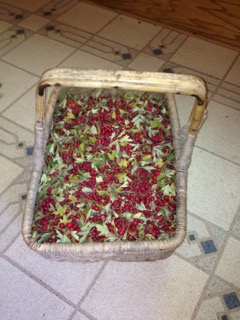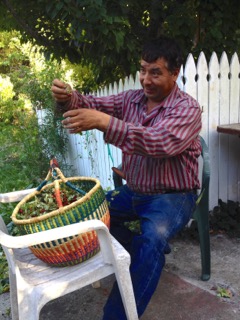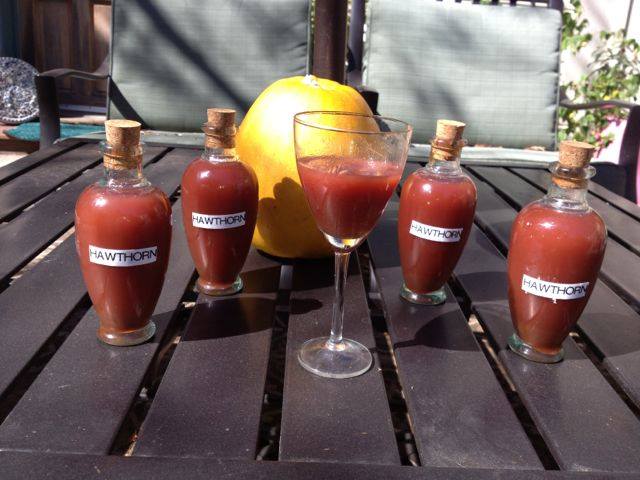|
How beautiful in autumn shadows, the blood red berries of hawthorn are! Drooping in small clusters along thorny branches they transform the final seasonal rays of the sun into a unique abundance of flavonoids and oligomeric anthocyanidins responsible, among other things, for their red color. Western Use of HawthornIt is the unique formation of these biochemical constituents that partially provide a scientific rationale for the beneficial effects hawthorn is known to have especially on the cardiovascular system. Their calming, circulation-enhancing, digestive and diuretic properties ease the fluidic burden of the heart, relieve peripheral arterial tension and allow for a freer flow of blood and lymph. The leaves, berries and flowers of hawthorn are used in medicine. We see how they benefit the cardiovascular system making it useful for congestive heart failure (CHF), angina (chest pain), irregular heartbeat. They treat both low and high blood pressure, hardening of the arteries (atherosclerosis) and cholesterol. By widening the vessels, increasing the amount of blood pumped out from the heart and increasing nerve signals responsible for smooth flow, hawthorn’s berries, leaves and flowers are able to gently treat most diseases. The anthocyanidins of the berries relax blood vessels and relieve hypertension, while the flavonoid-rich flowers and leaves have a direct hypotensive effect. Overall, hawthorn has powerful antioxidant protective effects on the heart, nerves and whole body. Hawthorn also lowers low density lipoprotein (LDL, or bad cholesterol), and triglycerides (fats in the blood). It reduces the accumulation of fat in the liver and aorta, which is the largest artery in the body, located near the heart. Like St. John’s wort extensively marketed for depression to the point that few are aware of its other uses, hawthorn is a popular herb known mostly for its effects of cardiovascular health. But it is also calmative, relieves dysmenorrhea, and benefits eyesight, to name a few of many possible other uses. Additionally, one of our most respected herbalists, Dr. Jim Duke is said to have suggested hawthorn as beneficial for ADHD children. Use of Hawthorn in TCMIn Traditional Chinese Medicine (TCM), the primary use of hawthorn species is to treat food stagnation from excessive meat and fat. It also treats indigestion, diarrhea and stomach pain. Despite the fact that hawthorn is not even traditionally described as affecting the Heart organ meridian, its effect on the TCM Spleen-pancreas, Stomach and Liver as stated in texts indirectly benefits the cardiovascular system. Always eager to learn a new herb or a newly emphasized property of an old herb, the Chinese have recently developed an appreciation for the benefit of hawthorn berries for the heart as outlined in the section above. (So far, Western herbalists, obsessed with the use of bitters for digestive purposes, have not yet come to accept hawthorn as a useful herb for digestion.) They are also used to reduce anxiety and as a sedative. ContraindicationsBecause of its popular use for the cardiovascular system, one should use caution when taking hawthorn with drugs such as digoxin that help the heart to beat more strongly, or nitrates which increase blood flow to the heart, high blood pressure medications such as beta blockers, as well as erectile dysfunction drugs such as Viagra, Cialis and Levitra with the risk that because of the danger that blood pressure might go too low. However, hawthorn is one of the mildest and most benign herbs used worldwide as a food and medicine over the last 2,000 or so years. I know of no recorded adverse reactions. Types of HawthornA member of the rose family, hawthorn is native to temperate regions of the Northern Hemisphere of Europe, Asia and North America with over 200 species with over 1,000 subspecies and hybrids. The most common European variety is Crataegus monogyna used in the UK and Ireland. Crataegus pinnatifida, the species most used in China, bears the largest fruit, about the size of a small crabapple. The once popular name found in older herbals, Craetaegus oxycanthus, has been rejected because of uncertain identification. Many don’t realize that besides the most common red, hawthorn fruit come in various colors including yellow and black. Happily enough for harvesting, some even lack thorns. The term “haw” is old English for hedge, a common sight in the British Isles countryside, where the hedges are usually living borders of hawthorn. Food UsesHawthorn berries are appreciated and used among country folk around the world who make them into jams, jellies, liquors, candies, and syrup. In Mexico they are called tejocotes and are eaten raw, cooked, in jam, or made into a popular confection called rielitos with sugar and chili. This is manufactured and sold by several companies in Mexico. The Mexican native species of Hawthorn, Cratageus Mexicana and C. stipulacea have yellow berries and are larger and meatier than the ones typically used in North America and Europe. This same species of yellow hawthorn has a history of use by the Aztecs as a diuretic for the kidneys and as a calmative. Similarly, Chinese hawthorn, Cratageus pinnatifida (shan zha) which I think has been adopted for use in Mexico, is also a larger berry and it is made into a sweet called “haw flakes.” They are a dark pink candy formed into thin wafers. These are often given after taking a bitter Chinese medicine and to increase the appetite of children. The Chinese also make a wine from the berries, as do the South Koreans where a popular hawthorn liquor is called sansachun. In Iran, the fruits of Crataegus azariolus var. aronia as well as other species are known as zalzalak and are eaten raw as a snack or made into a jam. In the Southeastern US, the native species, all called mayhaws, are considered a great delicacy and are made into jams, jellies and eaten as a snack. In the Northwest, a species of black hawthorn, Crategeus douglasii, is used as food and medicine. Hawthorn Fruit WineSo what does one do when one is confronted with a bountiful harvest of hawthorn berries? One can dry some of them, make an alcoholic tincture, jam, jelly, paste or fruit leather (I’m waiting o find a large-berried Crataegus pinnatifida for that task). How about making some delicious rose-red hawthorn wine?
(In the course of making hawthorn berry wine one of my students on the East Coast asked whether the North American dogwood berries were edible and have properties similar to Chinese dogwood (shan zhu yu)? This is another important underused botanical in the West and I’m happy to say that I believe the North American dogwood berries have similar properties, replenishing Liver and Kidney essence and furthermore they also make a fine wine for which the following recipe can be used. ) Ingredients:
Equipment:
* One can simply use baker’s yeast and skip the nutrient and the Campden but the resulting product may not be as good. All of these as well as bottles, labels corks and such can be purchased online or at a brewer’s outlet. Directions: Dissolve the nutrient in 1 cup lukewarm water and add the yeast. Let this stand overnight. Thoroughly wash all utensils pots and utensils. Wash the berries as well. Bring the berries and Campden to a boil in the 7 pints of water and let them stand until cool enough so you can put your hands in to mash the berries. While it is still warm, dissolve the sugar into the liqueur before or after putting the entire thing into a food grade plastic or metal receptacle. Always lightly cover the container to keep it ventilated to allow the fermenting gases to escape and to prevent things from falling in. After 24 hours, mix in the yeast mixture. Try to maintain a consistent temperature of 75 to 85 degrees Fahrenheit. You will first notice the entire thing come alive, fermenting and even forming a thick mash on the top. This can be left or removed as you please. After a week the entire thing can be strained to remove the seeds and other solid particles. After approximately 2 to 3 weeks the fermentation process should be finished as the sugar and nutrient from the hawthorn have been digested and converted to alcohol preserving all the medicinal properties of the herb into a highly assimilable form. This could be anywhere from 12.5 to 14.5% depending on how much sugar was used. I hope you will try your own hand at making hawthorn fruit wine!
|


 So on a beautiful sunny September day in the mountains of Santa Cruz, California, I decided to enlist the assistance of my friend Abel Canizal (pictured at left) and his nephew Evan to help pick and pull off some, though not all, of the leaves attached to the small drupe bundles of berries. Harkening back to my neolithic ancestors who may have been the first to make alcohol, I found myself committed to making 10 gallons of fruity hawthorn berry wine. My wife, Lesley, who is mostly supportive of my messy herbal ventures, asked what I was going to do with all of that hawthorn berry wine. I told her that I plan to drink some over the coming years because it will undoubtedly be good for my aging, sometimes aching, heart, give some bottles to very special friends, and hopefully have enough to spring out for ‘party night’ at the East West Seminar. As I thought of all of these occasions, I began to wonder if 10 gallons would be enough! In any case here I was with a whole lot of freshly picked hawthorn berries and only enough food grade plastic buckets to make 10 gallons of wine, so that would have to do. I had so much fun, I can’t resist sharing with you the recipe that I generally followed below.
So on a beautiful sunny September day in the mountains of Santa Cruz, California, I decided to enlist the assistance of my friend Abel Canizal (pictured at left) and his nephew Evan to help pick and pull off some, though not all, of the leaves attached to the small drupe bundles of berries. Harkening back to my neolithic ancestors who may have been the first to make alcohol, I found myself committed to making 10 gallons of fruity hawthorn berry wine. My wife, Lesley, who is mostly supportive of my messy herbal ventures, asked what I was going to do with all of that hawthorn berry wine. I told her that I plan to drink some over the coming years because it will undoubtedly be good for my aging, sometimes aching, heart, give some bottles to very special friends, and hopefully have enough to spring out for ‘party night’ at the East West Seminar. As I thought of all of these occasions, I began to wonder if 10 gallons would be enough! In any case here I was with a whole lot of freshly picked hawthorn berries and only enough food grade plastic buckets to make 10 gallons of wine, so that would have to do. I had so much fun, I can’t resist sharing with you the recipe that I generally followed below.
Love the intro paragraph to this article! Beautiful!